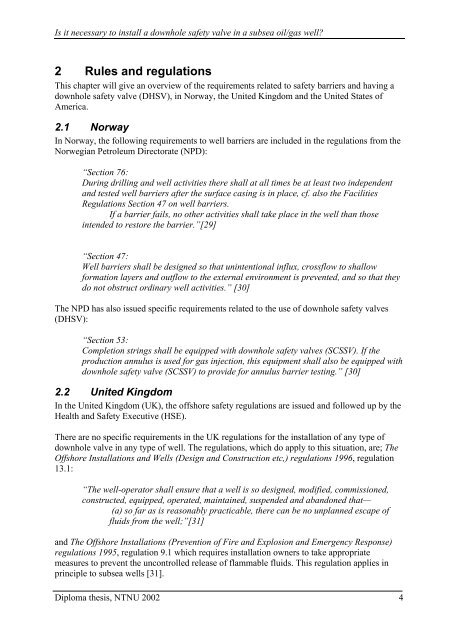Is it necessary to install a downhole safety valve in a subsea ... - NTNU
Is it necessary to install a downhole safety valve in a subsea ... - NTNU
Is it necessary to install a downhole safety valve in a subsea ... - NTNU
You also want an ePaper? Increase the reach of your titles
YUMPU automatically turns print PDFs into web optimized ePapers that Google loves.
<strong>Is</strong> <strong>it</strong> <strong>necessary</strong> <strong>to</strong> <strong><strong>in</strong>stall</strong> a <strong>downhole</strong> <strong>safety</strong> <strong>valve</strong> <strong>in</strong> a <strong>subsea</strong> oil/gas well?<br />
2 Rules and regulations<br />
This chapter will give an overview of the requirements related <strong>to</strong> <strong>safety</strong> barriers and hav<strong>in</strong>g a<br />
<strong>downhole</strong> <strong>safety</strong> <strong>valve</strong> (DHSV), <strong>in</strong> Norway, the Un<strong>it</strong>ed K<strong>in</strong>gdom and the Un<strong>it</strong>ed States of<br />
America.<br />
2.1 Norway<br />
In Norway, the follow<strong>in</strong>g requirements <strong>to</strong> well barriers are <strong>in</strong>cluded <strong>in</strong> the regulations from the<br />
Norwegian Petroleum Direc<strong>to</strong>rate (NPD):<br />
“Section 76:<br />
Dur<strong>in</strong>g drill<strong>in</strong>g and well activ<strong>it</strong>ies there shall at all times be at least two <strong>in</strong>dependent<br />
and tested well barriers after the surface cas<strong>in</strong>g is <strong>in</strong> place, cf. also the Facil<strong>it</strong>ies<br />
Regulations Section 47 on well barriers.<br />
If a barrier fails, no other activ<strong>it</strong>ies shall take place <strong>in</strong> the well than those<br />
<strong>in</strong>tended <strong>to</strong> res<strong>to</strong>re the barrier.”[29]<br />
“Section 47:<br />
Well barriers shall be designed so that un<strong>in</strong>tentional <strong>in</strong>flux, crossflow <strong>to</strong> shallow<br />
formation layers and outflow <strong>to</strong> the external environment is prevented, and so that they<br />
do not obstruct ord<strong>in</strong>ary well activ<strong>it</strong>ies.” [30]<br />
The NPD has also issued specific requirements related <strong>to</strong> the use of <strong>downhole</strong> <strong>safety</strong> <strong>valve</strong>s<br />
(DHSV):<br />
“Section 53:<br />
Completion str<strong>in</strong>gs shall be equipped w<strong>it</strong>h <strong>downhole</strong> <strong>safety</strong> <strong>valve</strong>s (SCSSV). If the<br />
production annulus is used for gas <strong>in</strong>jection, this equipment shall also be equipped w<strong>it</strong>h<br />
<strong>downhole</strong> <strong>safety</strong> <strong>valve</strong> (SCSSV) <strong>to</strong> provide for annulus barrier test<strong>in</strong>g.” [30]<br />
2.2 Un<strong>it</strong>ed K<strong>in</strong>gdom<br />
In the Un<strong>it</strong>ed K<strong>in</strong>gdom (UK), the offshore <strong>safety</strong> regulations are issued and followed up by the<br />
Health and Safety Executive (HSE).<br />
There are no specific requirements <strong>in</strong> the UK regulations for the <strong><strong>in</strong>stall</strong>ation of any type of<br />
<strong>downhole</strong> <strong>valve</strong> <strong>in</strong> any type of well. The regulations, which do apply <strong>to</strong> this s<strong>it</strong>uation, are; The<br />
Offshore Installations and Wells (Design and Construction etc,) regulations 1996, regulation<br />
13.1:<br />
“The well-opera<strong>to</strong>r shall ensure that a well is so designed, modified, commissioned,<br />
constructed, equipped, operated, ma<strong>in</strong>ta<strong>in</strong>ed, suspended and abandoned that—<br />
(a) so far as is reasonably practicable, there can be no unplanned escape of<br />
fluids from the well;”[31]<br />
and The Offshore Installations (Prevention of Fire and Explosion and Emergency Response)<br />
regulations 1995, regulation 9.1 which requires <strong><strong>in</strong>stall</strong>ation owners <strong>to</strong> take appropriate<br />
measures <strong>to</strong> prevent the uncontrolled release of flammable fluids. This regulation applies <strong>in</strong><br />
pr<strong>in</strong>ciple <strong>to</strong> <strong>subsea</strong> wells [31].<br />
Diploma thesis, <strong>NTNU</strong> 2002<br />
4


